Photo
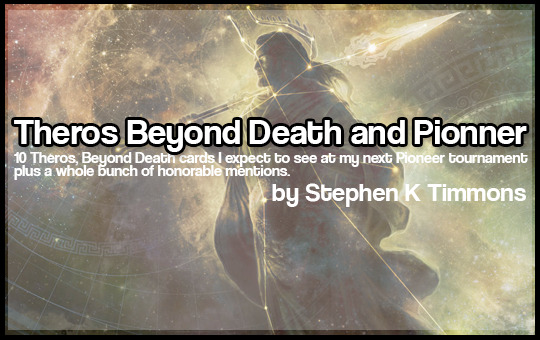
Let’s start with the top 10 and get to the honorable mentions and longshots after….
Top 10:
10. Tectonic Giant

(Frequency = Low, Impact = Low) Possible Homes: Temur Elementals
A hard-to-deal-with threat that an opponent must deal with has possible applications in Pioneer but 4 mana is lot for most of the decks that might want this. Temur Elementals is one possible home but I would definitely expect that if I do see this card it will be paired with green accelerants.
9. Woe Strider

(Frequency = Low, Impact = Medium) Possible Homes: Aristocrats (of some color combination)
Aristocrats is a deck that is perpetually on the fringe of playable in both Modern and Pioneer. There are already more than enough playable cards for the archetype in BR, BRW, BGW or even some more obscure color combinations so the thing that will make the deck better is finding cards that can double up on roles to increase the card quality. Woe Strider fills the two most important roles in an Aristocrats deck; extra bodies in the form of goats and a sac outlet as well as also providing some reach and card selection. I feel sure enough about Woe Strider making Aristocrats playable that I moved it from the “If…then…” section to my top 10. Depending on the best color combination for the deck, Slaughter-Priest of Mogis and Alirios, Enraptured may also see some play.
8. Ashiok, Nightmare Muse
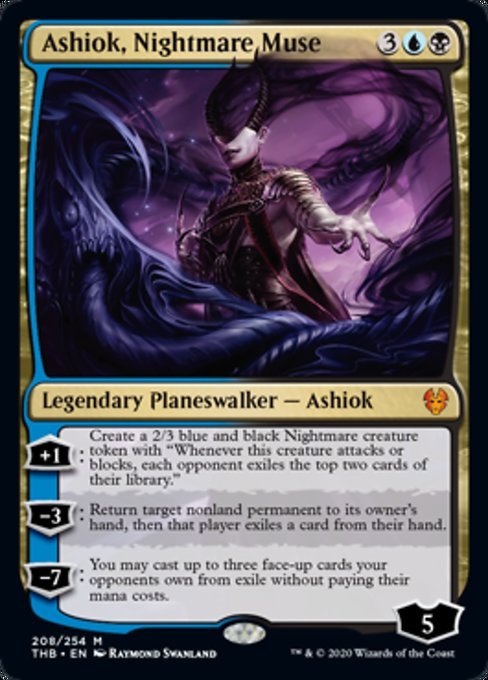
(Frequency = Low, Impact = Medium) Possible Homes: UBx Control
Makes the list on the power of having a plus ability that makes blockers to protect it while threatening an ultimate in only two turns. If you play Ashiok while ahead you will probably win the game. It’s closest competition is probably The Scarab God, and in parity and while ahead this card is close to that power level. Its worse when you’re behind but has less deck-building restrictions so overall I like this card and I can’t wait to win some games with my opponents’ stuff.
7. Staggering Insight

(Frequency = Low, Impact = Medium) Possible Homes: UW aggressive flying decks like Spirits
I feel like people are sleeping on this card but as Curious Obsessions number 5-8 that also grant lifelink I think it’s pretty good. Mono-red doesn’t want to see this on a spirit if you also have Selfless Spirit in play and I know that control decks don’t want to get hit by it. The card on this list that’s probably most likely to miss (along with Tectonic Giant) but I think it will see some play.
6. Storm’s Wrath

(Frequency = Medium, Impact = Medium) Possible Decks = Jeskai Fires, RB Control
Great rates on red’s Wrath of God that also hits Planeswalkers means you will be seeing this card. It does come with some heavy deckbuilding constraints but the value is there for those who can fit it in to their strategy.
5. Phoenix of Ash

(Frequency = Medium, Impact = Medium) Possible Decks = Phoenix, Mono-red agro, Dredge
A recursive hasty threat is just what many mono-red decks want as the top-end of their threats and it also plays nicely with a lot of the cards in UR Phoenix, although it fights with Treasure Cruise. Making sure you can interact with graveyards is starting to seem like a priority in Pioneer just like it is in older formats.
4. Kunoros, Hound of Athreos
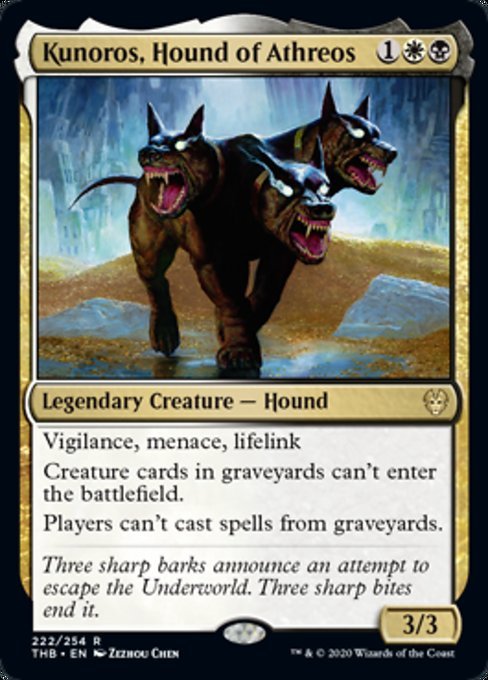
(Frequency = Medium, Impact = Medium) Possible homes: BW midrange, Abzan Midrange, 5c Niv to Light
This set’s best “pile of abilities creature”, Kunoros packs a lot of punch into a 3/3 for 3. Having a bunch of abilities on a creature doesn’t always lead to a successful Magic card (see: Savage Knuckleblade), but Having abilities that are particularly good against two disparate kinds of decks makes Kunoros intriguing. If 3 toughness in Pioneer is truly akin to 4 toughness in Modern (outside the range of the most common removal) then I think Kunoros will be giving aggro decks and graveyard decks fits for the foreseeable future.
3. Polukranos, Unchained

(Frequency = Medium, Impact = Medium) Possible Homes: Hardened Scales, Escape Strategies (Sultai?), BG Midrange Strategies
Polukranos provides a lot of undead beef for its mana cost, both at cmc=4 and cmc=6. I expect to see the big Zombie Hydra augmenting an already good Hadened Scales plan of attack as well as enabling a few other midrange strategies to finish off their game plans. Bonus points if you can utilize the counter aspect or give Polukranos trample and/or Haste but even by itself this is a fine creature.
2. Heliod, Sun-Crowned

(Frequency = Medium, Impact = High) Possible Homes = Mono-White Devotion, Soul Sisters, Collected Company Decks, Hardened Scales Decks, Any deck that already plays Walking Ballista
The boogie man cometh. Heliod is a card so scary that lots of people are already talking about a Walking Ballista ban in Pioneer’s future. While the combo is obviously scary and something you have on your radar any time you’re playing Pioneer I don’t think it’s quite to that level. Outside of winning the game on the spot, Heliod slots in nicely next to Benalish Marshall in a White Devotion/Beatdown strategy, perhaps utilizing other Theros cards; Favored of Iroas and Taranika, Akroan Veteran (which are both soldiers as well). The other white devotion deck possibility is probably more of a “pillow fort” kind of deck utilizing white’s many enchantments that make it hard for your opponent to win. That deck has the added benefit of wanting to play Walking Ballista alongside Nykthos, Shrine to Nyx already and also likes the lifegain Heliod can provide.
1. Uro, Titan of Nature’s Wrath
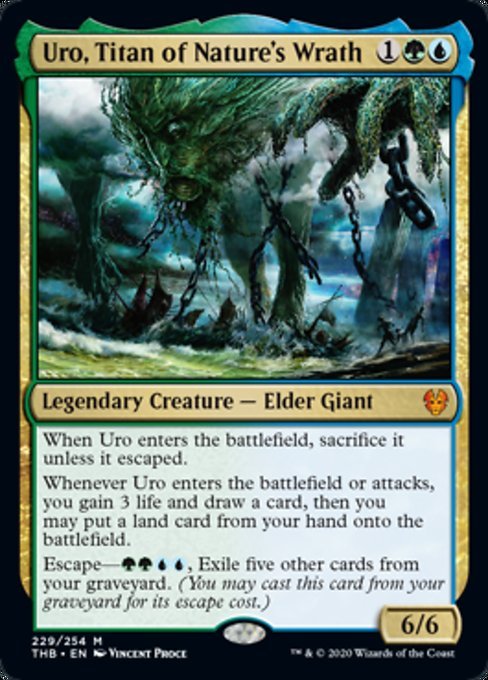
(Frequency = High, Impact = High) Possible Homes = UG Ramp Strategies (including Devotion), 5c Niv to Light, Escape Strategies, Maybe Soulflayer
My pick for the card that will have the biggest impact in Pioneer, Uro packs a lot of value into one card. UG ramp strategies with and without devotion will love this card and it slots perfectly into Niv to Light as a ramp spell which also gains you some life early and gives you more reach late. Uro will probably also spawn some new strategies all by itself like UGx control or some sort of escape deck that includes some self-mill. Expect to see a lot of this card going forward and expect to die to it eventually if you can’t deal with it permanently.
Honourable Mentions
Playable Removal Spells:
Eat to Extinction and Drag to the Underworld will both compete with the format’s best removal and will see some play but I don’t think they are appreciably better than Fatal Push, Abrupt Decay, Vraska’s Contempt, Murderous Rider or even Murderous Cut. Keep in mind that Drag to the Underworld’s upside is a one mana break on Murder, have you ever thought about playing Murder in Pioneer?

Cards to Help you Out Against Mono-Red:
Erebos’s Intervention, Shadowspear and Setessan Petitioner provide more ammunition for decks that have trouble with mon-red or other aggressive decks. The Petitioner is definitely a sideboard card whose cmc probably makes it an upgrade over Nylea’s Disciple. The other two may be maindeck cards in the right deck (perhaps UR Ensoul for Shadowspear) but probably also head to the sideboard.

“If _________________ is a good deck then this card will probably see play in it.”

Callaphe, Beloved of the Sea is a good body for blue Devotion strategies along with Thassa, whose blink effect is proving to be better in testing then I expected. Green devotion decks may want Omen of the Hunt and some will probably try Nyxbloom Ancient but that card definitely screams “win more!” to me.
Longshot Squad
Could any of these have a chance? Probably not, but crazier things have happened.
Gaalia of the Endless Dance
Firedrinker Satyr, Satyr Hedonist, Boon Satyr and the new Careless Celebrant….You’re right, those are not the cards a good Pioneer deck are built around but it’s too bad, this card is efficient and a cool effect to have in an aggressive tribal deck. Maybe when we go to Theros next time we’ll be able to complete this deck. Gaalia might just be good enough to get there on its own in a Gruul agro deck but usually if you’re attacking with three or more creatures in that kind of deck you’re already winning anyway.
Dalakos, Crafter of Wonders & Nyx Lotus
There isn’t a precedent for a three cmc mana-producing creature to be good in the format but I can’t help but wonder if this card can do something with Paradox Engine. Nyx Lotus could go in that deck as well. Maybe mostly blue with a red splash and including Emry, Dalakos, Saheeli, Mox Amber (Which Dalakos helps out), Nyx Lotus, Paradox Engine….
Storm Herald & Mantle of the Wolf
Could Storm Herald spawn an aggressive combo deck? Prodigious Growth and Spectra Ward are probably the two best creature auras to use with Storm Herald and you probably need something like Battle Mastery and/or one of the lifelink enchantments. We have a lot of red rummaging effects like Cathartic Reunion, Tormenting Voice and the new Thrill of Possibility as well as perhaps Thirst for Meaning out of blue to set things up. It’d be nice to be able to bring back Control Magic effects and enchant your opponent’s creatures but, c’est la vie, there may be something here.
Nadir Kraken
Look man, I don’t know why I like this card, but there’s just something about it. Maybe because Squirrel Opposition is my all-time favorite deck and this card makes me nostalgic for constant token generation. I’m at least 95% sure this won’t be a playable card in Pioneer but I’m also 95% sure I will own too many foils of it for the chance that it becomes playable.
Underworld Breach, Aphemia, Calix & Kroxa
What do we do with these cards? I don’t know, but someone is going to try. Underworld Breach obviously has the most potential but may need the larger card pool eternal formats to really shine. If you squint really hard Aphemia has Bitterblossom potential. Calix is a really interesting build around for enchantment-heavy strategies. Kroxa might want someone to introduce them to Davriel to really make opponents miserable.
- Stephen K Timmons
2 notes
·
View notes
Photo

Frogtown Hobbies in Rossford, Ohio hosted a Starcity Games Invitational Qualifier on December 14. The format: Pioneer, the number of players: 39, the unbanned cards: still Oko and Nexus of Fate, unfortunately. Let’s dive into the results and see what can be gleaned from a bit of analysis.
As a reminder, Pioneer is Magic’s newest non-formatting competitive format and includes all cards from Return to Ravnica (October, 2012) forward. An interesting dynamic is at play between today’s hyper-fast exchange of information on the internet and the constant upheaval of near-weekly banlist changes as the format grows. Accordingly, two months in to Pioneer I don’t think anyone is sure exactly how “solved” the format is. Let’s delve into this quagmire of uncertainty and see if we can find any beacons of truth.
Tentative truth #1: Simic in general and Oko, Thief of Crowns and Nexus of Fate specifically were too strong for the format.
Two days after this tournament Wizards of the Coast saw fit to ban these two Simic cards. For Oko, WotC cited the “nearly 60% non-mirror win rate” and high number of 5-0 league finishes of the Simic Food Ramp deck as well as the presence of Oko in “several of the other strongest decks” as their banning rationale. For Nexus of Fate the high number of league finishes was also cited as well as their assertion that “Simic Food Ramp was one of the Simic Nexus deck's only unfavorable matchups among top decks”.
Well our tournament saw five players sleeve up some number of these banned cards and their results do give credence to WotC’s arguments. The total win rate for these 5 decks against the rest of the field was a hair under 70% (16-7) and two of the five made top-8 with two more in 9th and 14th place. Leading the pack and splitting in the finals was Raymond Perez on Simic Nexus.

Perez did not lose a match on the day, going 4-0 into double ID and splitting in the finals. Along the way he beat GB midrange, UG Food, UW Control, Izzet Phoenix, UW Control again (quarterfinals) and Izzet Phoenix again (semifinals).
The other top-8 player on future-banned cards was Santiago Lizcano on Simic Stompy who lost in the other half of the semifinals.
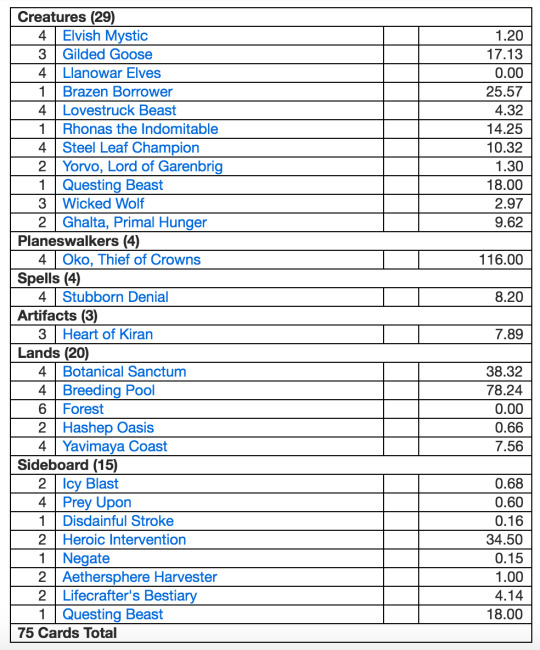
Here we see Oko augmenting a large creature plan and ensuring that whatever your opponent plays its going to be a smaller creature (as a 3/3 Elk) than your creatures. Lizcano went with the slightly beefier version of this deck, opting for 2 Ghalta, Primal Hunter and 2 Yorvo, Lord of Garenbrig in the maindeck. He also gambled a bit that his first turn mana dorks would live, running only 20 lands to go along with 11 such creatures. I also want to point out that Lizcano successfully came back from 0-1-1 to make top-8, which is definitely doing it on hard mode. He lost to UW Control in round 1 before drawing with Jeskai Fires in round 2. He then rattled off victories over Mono Black Aggro, UW Control, Abzan Aristocrats (!), Simic Ramp and Red Deck Wins (quarterfinals) before losing to UW Spirits (I’ll get to that).
The other two players on Oko decks to make the top-8 were Justin Krieg (9th place piloting my version of Bant Walkers that I loaned him) and Dominic Mayhew (14th place with Simic Food Ramp). Was Oko too strong for the format? Almost certainly yes. Was Nexus of Fate too strong for the format? Possibly, but it’s also super un-fun to play against and to watch on coverage so its leash was shorter. I bid both of these cards adieu.
Tentative Truth #2: UW Control and Red Deck Wins are both good choices going forward and their matchup may provide the backbone of the format going forward.
I’m lumping these decks together because they were the two most played decks on Saturday (8 UW Control and 6 RDW), both faired poorly against the Simic decks, neither one loses anything in the bans and because nobody seems to agree on the right way to build either of them. On the other hand, despite each taking one player to the top-8 they did not have the same level of results across the board.
UW control ended up with a 47% non-mirror match win percentage (17-19) when you include Keith Duncan’s Esper Control list in with them (he finished 2-2 in non-“mirrors”). While that’s obviously not great is does include a 2-6 record against decks with Oko or Nexus which will no longer be around to prey upon slow control decks. One might think that presence of a large number of mono-red decks also contributed to the losing record but in fact RDW and UW control split their 8 matches against each other 4-4. Here’s Dustin Klopping’s top 8 List, but like I said earlier, there is a lot of variability between the 8 UW Control lists played on Saturday:

The one big thing that sets Klopping’s list apart are the full set of 4 maindeck Detention Speres. Along the way to the top-8 he beat Mono-Black Vampires, UW Control, Esper Control, RDW and lost to Simic Food Ramp before drawing into the top-8 and losing to Simic Nexus.
Mono-red decks had much better results than UW Control, winning nearly 56% of their non-mirror matches. Like the control deck they did not do well against the Simic decks (but in only 4 matches [1-3]). The builds of mono-red were even more variable then the UW Control lists. Here’s Ben Vasko’s top-8 list that was designed by Cory Brannon:

We’ll have to wait and see how mono-red decks settle into the new post-Oko world. Does Hazoret make the cut? Earthshaker Kenra? Cavalcade of Calamity, Legion Warboss and Chandra, Acolyte of Flame (All used by Matthew Stinehart to take 10th place)? I don’t know but I feel safe in assuming that I will have to play against some number of mono-red decks at my next Pioneer tournament.
Tentative Truth #3: You want some spice? You can play some spice!
Behold, the other deck that split in the finals, Jonathan Jackman’s UW Spirits:

Jackman went 2-0 against banned card decks, lost once to mono-red (Top-9 player Ben Vasko in round 3) and beat Abzan Midrange, Gruul Aggro and Jeskai Fires. If you like blue tempo decks, this is probably the way to go.
Maybe paying for your spicy spells isn’t really your thing. How about Jyrik Fields’ Jeskai Fires:

Like Santiago Lizcano, Jyrik Fields also made top-8 on hard mode, starting out with a loss against RDW (Ben Vasko again) and that unintentional draw against Simic Stompy. He then beat RDW, Boros Aggro, Esper Control and Izzet Tempo before bowing out in the quarterfinals against Jackman’s Spirits deck.
Brennan McAlear proved that getting 3-power hasty flyers into play just by casting your spells is still a real way to win in Pioneer, making top-8 with Izzet Phoenix:
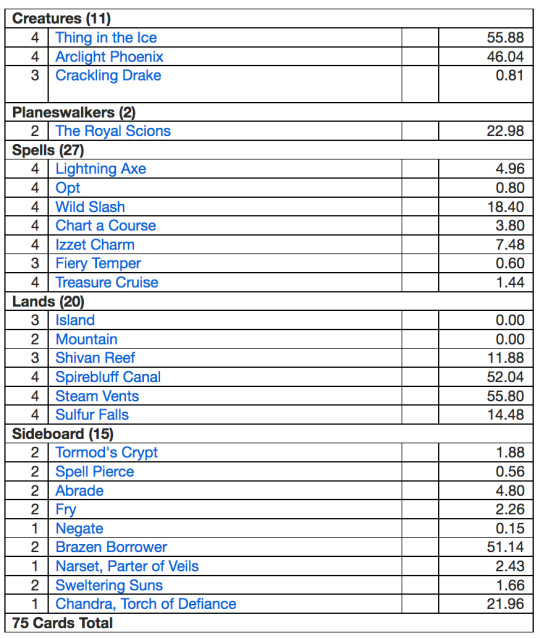
Brennan only lost twice on the day, both times to the now-banned Nexus deck. Don’t count this deck out in the new format.
Last but not least, we have this piece de resistance by John Mezinko, 5c Niv to Light:
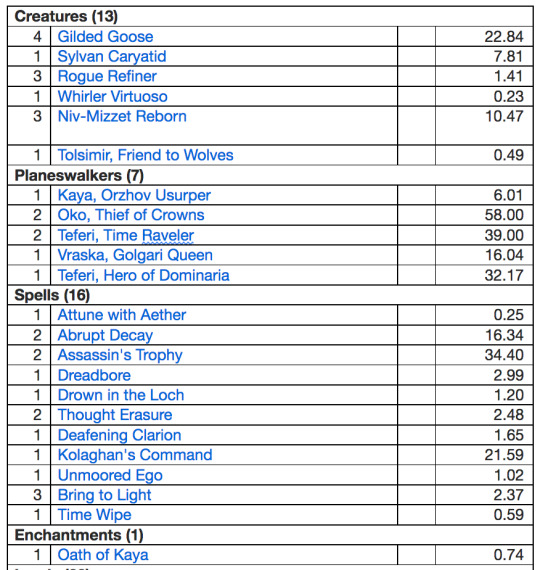

Do you want to use Teferi, Time Raveler to cast Bring to Light at the end of your opponent’s turn and put a Niv-Mizzet Reborn into play, netting 4 cards including another Bring to Light? How about on the next turn casting another Bring to Light during the attack step to play a Time Wipe, kill all your opponent’s stuff and get your Niv Mizzet back in hand to cast again the next turn? This deck does stuff like that, it’s glorious. Like Brennan McAlear, Mezinko only lost to one player on Saturday. In fact, it was actually McAlear who beat him, once in rd 3 and another time in the quarterfinals. He beat Mono-Red twice and UW Control once so this is another deck to keep an eye on. Its obviously very customizable as well so adapting to a new metagame is probably reasonable but it may need a settled field to really optimize the list.
Thank you for reading, hopefully we’ll see you all at Frogtown’s next Pioneer SCG IQ on January 25th. Keep brewing.
-Stephen K Timmons
3 notes
·
View notes
Photo

On August 24 Frogtown Hobbies hosted a Mythic Championship Qualifier, the first in their history, and the only one being run in Northwest Ohio for the season. The format was modern and after SCG IQs in the last two months drew 60+ competitors excitement was high, especially with $3000 being given out to the top 16. We ended up with 98 players from throughout the tri-state area as well as southern Ontario. In the end it was Timothy Robertson and his Boros Burn deck that took the crown and the invite to the November Mythic Championship in Virginia by defeating Quang Vu on Urza Sword.
The field showed a little more homogeneity than either of the recent IQs with 17.3% of players bringing the boogeyman of the format, Hogaak. Recent analyses by Frank Karsten and Tobi Henke at Channel Fireball having shown the dominance of the deck in modern probably contributed to that percentage. It should be noted that the diversity of modern still means that you would have about a 26% chance of dodging Hogaak for all 7 rounds. The Urza, Lord High Artificer/Thopter Foundry/Sword of the Meek deck (Urza Sword) was the second most played deck on the day at 12.2%. It is widely regarded as having one of the best Hogaak matchups in the field and is very good against creature decks but current configurations struggle against both burn and tron. Mono-red Phoenix, mono-green Tron and Burn rounded out the five most played decks. Please note that on the accompanying chart mono-green tron is split into versions with (8 total) and without (3 total) Karn, the Great Creator.

Due to the recent banning of Hogaak, Arisen Necropolis and Faithless Looting and unbanning of Stoneforge Mystic I decided to keep my matchup analysis for this tournament brief. There are some interesting and useful pieces of information that can be gleaned however if one delves into the results. Let’s start with the day’s best performing decks by average results, these decks all did very well in small sample sizes (3 or less players each), don’t lose anything after the bans and remind us that no matter what we think we know about modern somewhere, someone disagrees and will beat you if you’re not prepared for them. Ten players all together chose to play either Infect, Abzan Midrange (!), Amulet, Humans or Affinity. While none of those players made top-8 they all finished on at least 9 points with Kevin Mcleskey finishing in ninth place on tie breaks (5-1-1) with Humans and exactly one player finishing on 5-2 for each deck. Jon Koch’s strong finish with Abzan Midrange is especially interesting due to the possibility of slotting Stoneforge Mystic right into that deck. I would also like to call out Andrew Wolthuis of Swish Gaming for thoroughly wrecking me (on Urza Sword) in round 4 with a game 1 first turn Hope of Ghirapur out of his Affinity deck.
The middle chunk of the chart contains all of the most heavily played decks except 1 (we’ll get to you, Jund) and a range of average performances from very good (Urza Sword and Burn) to slightly below average (Hogaak). It should be noted that the overall mean for this dataset is 8.37 and the overall median is 9. Furthermore, the more copies of a deck in the tournament, the more likely it is to approach the mean/median. Urza Sword and Burn were the big winners on the day, populating the top tables all tournament long and bagging 4 of the top-8 spots. As mentioned above, Timothy Robertson took down the tournament with his Boros Burn deck (playing 3 sb Leyline of the Void, 2 sb Shattering Spree and a 2-2 split of Skullcracks). Timothy did get to face a favorable matchup in Urza Sword in the semifinals and finals but definitely proved his mettle all day, beating unfavorable matchups Hogaak twice and Eldrazi Tron once. In addition to Robertson, Drew Johnson and Corey Petryschuk both managed 5-2 records to help bring up Burn’s average up. Urza Sword put three players in the top-8 (Quang Vu, Joel Holosko and Austin Davis) with Vu losing to Robertson in the finals. Davis opted for a white splash for Teferi, Time Raveler, Holosko went with a green splash for sideboard cards and Vu went ahead and did both, leaning on his Mox Opals, Arcum’s Astrolabes and a pair of Chromatic Stars to help him cast 5 colors worth of goodness. Urza Sword is definitely one of the favorites to be a top deck going forward with some people even suggesting it as a possible home for Stoneforge Mystic. Personally I want to take advantage of a probable decrease in graveyard hate to try out Trash for Treasure in the deck (which combos nicely with Goblin Engineer). I seperated mono-green Tron decks in the chart to show the split between the two most common versions of the deck with those variants running Karn, the Great Creator (and its sb package) finishing notably worse than those who eschewed the Silver Golem. Kyle Boggemes took one of those copies without Karn to the top-8, presumably using his superior magical skills to beat three mirror matches along the way.

Despite big (justifiable) hype Hogaak decks did not perform well as a whole on Saturday with the average finish being worse than any other heavily played deck. Definitive “best decks” do have a tendency to draw a lot of players who haven’t played them extensively and their opponent is often more experienced playing against their deck than they are playing it. I’m not sure if this is what happened here or if perhaps the amount of hate in the format just finally reached the necessary level to contain the undead. Either way, 7 of the 17 players who sleeved up Hogaak finished with 1 or less match-win on the day. James Quinn and Allison Coleman both made top-8 but bowed out in the quarterfinals. The last deck I want to point out from this section is mono-R Phoenix which thoroughly supplanted the older Izzet version of the deck by the end of Hogaak summer. Wes Williamson carried this group with a top-8 appearance while most pilots finished around 9 points for the day. I used Tobi Henke’s math-up analysis article to figure out what odds every top-8 competitor overcame to make the elimination rounds and found that Williamson had the toughest path. Given his matchups in the first 6 rounds he had only a 7.36% chance of being 5-1 or better with especially tough matchups for his deck being Eldrazi Tron in round 1, Twiddle Storm in round 3 and Hogaak in round 6 all of which he beat so good on him. If you’re interested here are every other top-8 player’s odds for reaching 5-1 or better given their matchups:

*Please note that these are very rough as they make a lot of assumptions about decklists and the importance of player skill but they do illustrate how important matchups can be. For a baseline, 50% matchups all day would give a 10.9% chance of 5-1 through 6 matches.
The bottom of the chart comprises 12 little-played decks that managed averages of 2 or less wins each (topping out at a couple of 9-point finishes for Goblins and Grixis Death’s Shadow) and Jund. Jund was definitely the big loser on the day with five players managing to eke out a total of 8 wins between them. Having bad matchups against Hogaak, Urza Sword, Burn and Tron was definitely not an enviable place to be on Saturday. I know a lot of people have been talking about Jund being potentially good against Stoneforge Mystic but with three of those decks not losing anything to the bans Jund may need to stay on the sidelines for a while longer.
With Faithless Looting and Hogaak leaving the format I believe the best place to be will be leaning on the remaining busted cards, namely Mox Opal and Ancient Stirring or playing one of the reliably fast decks with a little bit of disruption. My preliminary top 5 modern decks for the new format are Urza Sword, Affinity/Hardened Scales, Tron, Burn and Amulet. Of course, modern is famed for its diversity so there are another 20 decks after that that will give you a chance on any given day with Storm, Infect, Humans, Bogles and Amulet Titan being my picks for most likely to break into that first tier. Personally I have been really enjoying a Bant Flash Snow deck lately and I think it has chops but we’ll see. I think that Stoneforge Mystic doesn’t quite play on the right axis to heavily impact modern but that UW control is likely to get a little better with access to it. I will not miss Hogaak but for those who did play it I offer this small condolence, you can’t play Looting or Hogaak but you can still play Ideas Unbound and Demon of Death’s Gate. That’s something, right?
-Stephen K Timmons
0 notes
Photo

Last weekend Frogtown Hobbies hosted a modern format Star City Games Invitational Qualifier and pulled in an exciting field of 62 players from all over Ohio and Michigan. Later this month (Saturday, August 24th to be specific) we are holding our first ever Mythic Championship Qualifier and the format will again be modern, so we thought a brief analysis of the decks played last Saturday would be informative for anyone coming out in a few weeks. Two notes before I begin; first, space will be limited for the MCQ and we are capping attendance at 132 so if you are planning on playing, sign up sooner rather than later. Second, while 62 players is a good turnout for an IQ, all analysis in this article still comes with a small sample size warning. This last point is accentuated by the disparity in player skill at local tournaments. That being said, on with the analysis.
The Field
Modern is, of course, a hugely diverse format with anywhere from 10 to 40 decks being competitive, depending on how strictly you define competitive. Using MTGTop8.com we see that 9 different modern archetypes have managed to top-8 at least 10 times in the last 2 weeks alone, 21 have at least 4 top-8s, 32 have at least 2 top-8s and a full 50 have managed to make at least 1 top-8. By this metric Dredge (which includes Hogvine decks on MTGTop8) leads the way with 53 top-8s (15%) followed by Phoenix variants (mostly UR or mono-R) with 37, UW Control (28), Eldrazi Tron (25), Urza’s Foundry (23), Classic Tron (23), Burn (22) and Jund (21). Mythic Championship IV in Barcelona had 11 different decks played by at least 10 players and 20 played by at least 3 led by Hogvine (98 players), UR Phoenix (48 players), Eldrazi Tron (42 players), Humans (38 players), UW Control (38 players) and Jund (36 players).
The Frogtown IQ was no less diverse, with 24 different archetypes being played by its 62 players and 13 being played by at least 2 players. Like the Mythic Championship the week before Hogvine was the most played deck with 8 intrepid pilots braving the seas of graveyard hate for the possibility of its explosive starts. All of the Hogvine decks played were pretty uniform in the maindeck with the only decision point seeming to be what removal suite to use in the last 3-5 slots between Lightning Axe (most popular), Assassin’s Trophy, Abrupt Decay and Fatal Push (least popular). Despite its heavy representation, Hogvine players were shut out of the top-8 with it’s best performance being put up by Michael Barabe in 9th place at 4-2.
The second most popular deck was Jund, right behind Hogvine with 7 players. Befitting of a midrange deck built around answering threats the Jund decklists were very diverse.Wrenn and Six was universally adopted with everyone running between 2 and 4. All 7 players also ran some number of Inquisition of Kozilek, Thoughtseize, Tarmogoyf, Lightning Bolt and Liliana of the Veil, and 6 of 7 players also ran some number of Bloodbraid Elf and Assassin’s Trophy. Raja Sulaiman managed the archetype’s only top-8 with one of the most unique lists, splashing white for 3 maindeck Path to Exile (with the 4th in the sideboard) to compliment a full boat of Assassin’s Trophies and fully tax his opponents’ basic land counts. The fourth color probably precluded Raja from playing a ghost quarter or two but modern’s basic land light decks are definitely ill-equipped to handle that many of that effect.
A trio of very disparate deck choices were brought by 5 players each in Monogreen Tron, Burn and Urza’s Foundry (sometimes called Grixis Urza or Whirza). Tron lists are obviously pretty stock at this point with the variety basically boiling down to whether to run the Karn-Lattice package or not. Notably, our five players all chose not to, led by Nick Moore who managed to top-8 despite leaving his trusty Celestial Colonnades at home. The burn decks were similarly uniform with all five players running nearly identical 75s. All five were RW (with one lightly touching green for some sideboard cards) and all 5 ran Skewer the Critics, Boros Charm and Lightning Helix on top of the usual suspects. One burn player made top-8 with the archetype, Peter Duhamel II. Urza’s Foundry was the final deck to be brought by 5 players and, despite the deck being fairly new to Modern, there was not a lot of variation in the lists. Teferi, Time Raveler was in the maindeck of 3 of the lists (and the SB of another), 4 of the players ran Goblin Engineer, 1 player ran a Time Sieve and another ran the Karn package but for the most part the decks were pretty uniform. Yours truly was the only player to top-8 with the archetype, running it back for my second straight top-8 with it.
The rest of the decks to be played by at least 2 players were Humans (4 players, 1 top-8), Mono-R Phoenix (4 players, 1 top-8), UW Control (3 players), UR Phoenix (2 players, 1 top-8), Affinity (2 players), Goblins (2 players), TitanShift (2 players) and Eldrazi Tron (2 players). For those of you counting at home thats 7 of the 8 Top-8 slots. With the last slot being taken by the eventual winner Jarad Carroll on RW Reckoner (!!) thats a full 8 distinct archetypes (depending on how you feel about UR vs mono-R Phoenix). Our 13 decks with multiple pilots were the same as the 13 decks with more than 10 players at the Mythic Championship with 2 exceptions (Goblins and Affinity at Frog Town vs 2 different Dredge variants in Barcelona).

Results
I mentioned the top-8 decks above but let’s look a little more in depth at how decks did during the IQ. Tracking all 13 2+ pilot decks, along with the “other” category, we saw three distinct tiers emerge from the tournament. Tier 1 (Humans, UR Phoenix, Affinity, Mono-R Phoenix and Tron) all saw their players post mean and median point totals of 9 or more and match win percentages greater than 54%. Humans had an especially good day in terms of number of standings points with its players managing 3, 12, 12 and 15 points led by Max Hersch���s top-8 appearance. UR Phoenix had only 2 players but one made top-8 (Joe Romeo) with a 4-0-2 record that buoys the match-win percentage for the archetype. Affinity also had two players (who finished on 12 and 6 points). Mono-Red Phoenix was all over the map with point totals for its four players of 3,6,12 and 15 (A top-8 for Aaron Miotke).
The second tier of decks (Burn, Whirza, Hogvine, Jund, Goblins and UW Control) all had mean and median point totals between 6 and 9 and match win percentages between 42% and 54%. It should be noted that the more players a deck has the harder it is to move into the top tier just based on there being a limited number of places available at the top of the standings. Accordingly we see most of our top played archetypes here in the middle tier.
The lowest tier of decks includes the 11 decks in the “other” category as well as Titan Shift and Eldrazi Tron. Besides Jarad Carroll’s Reckoner deck no singleton deck finished higher than 9 points. Titan Shift and Eldrazi Tron had especially bad days at the office with final point totals of 0, 9, 3 and 3 combined.

Conclusion
Overall, it looks like the best plan for the IQ was to be aggressive with a little bit of disruption as this adequately describes Humans, both Phoenix decks, Affinity, Burn and Hogvine. The little bit of flux caused by recent strong Modern sets like Modern Horizons and War of the Spark makes it hard to play control (where a settled field helps make sure you play the right answers). Of course, the deck that won took advantage of all of those aggressive decks (beating BR Elementals, Devoted Vizier, Affinity, Humans, Burn and Mono-R Phoenix while losing only to Whirza) by playing maindeck Auriok Champions, Worships, Blessed Alliance, Pyroclasm and Blasphemous Act to the top of the heap so there’s that.
Boros Reckoner Swans
Jarad Carroll
1st Place at Star City Games Invitational Qualifier on 8/3/2019
Creatures (19)
4 Auriok Champion
4 Boros Reckoner
2 Spiteful Sliver
2 Swans of Bryn Argoll
2 Volcano Hellion
4 Wall of Omens
1 Hazoret the Fervent
Planeswalkers (2)
2 Chandra, Torch of Defiance
Lands (21)
2 Mountain
6 Plains
1 Bloodstained Mire
1 Clifftop Retreat
4 Inspiring Vantage
2 Marsh Flats
2 Sacred Foundry
3 Wooded Foothills
Spells (18)
2 Rest in Peace
2 Worship
1 Blessed Alliance
3 Lightning Bolt
3 Path to Exile
1 Blasphemous Act
4 Faithless Looting
2 Pyroclasm
Sideboard
1 Pithing Needle
3 Blood Moon
2 Leyline of Sanctity
1 Rest in Peace
2 Stony Silence
1 Boil
1 Wear
2 Anger of the Gods
My recommendation is the same as it always is in modern: either play something proactive with just enough disruption or win the matchup lottery and coast through without playing decks that beat you. Good luck to all of those coming to Frogtown’s Mythic Championship Qualifier, I’ll be there battling it out for fame and glory, stop and say hello.
-Stephen K Timmons
0 notes